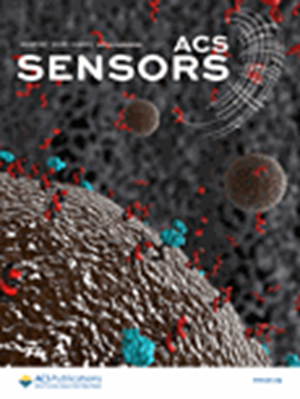Wearable 3D-Printed Microneedle Sensor for Intradermal Temperature Monitoring
IF 8.2
1区 化学
Q1 CHEMISTRY, ANALYTICAL
引用次数: 0
Abstract
Accurate temperature monitoring plays a crucial role in understanding the physiological status of patients and the early diagnosis of diseases commonly associated with local and global infections. Intradermal temperature measurement is, in principle, more precise than skin surface detection, as it prevents interference from environmental temperature changes and skin secretions. However, to date, precise and reliable intradermal temperature monitoring in a real-time and continuous manner remains a challenge. We propose herein high-resolution 3D printing to fabricate a mechanically robust and biocompatible hollow microneedle, filled with a temperature-responsive conducting polymer (poly(3,4-ethylenedioxythiophene): polystyrenesulfonate, PEDOT:PSS) to develop a microneedle temperature sensor (T-MN). The significance is 2-fold: rational design of robust MNs with high resolution in the micrometer domain and the implementation of a conducting polymer in a MN format for temperature sensing. The analytical performance of the developed T-MN is in vitro evaluated under mimicked intradermal conditions, demonstrating good sensitivity (−0.74%° C–1), resolution (0.2 °C), repeatability (RSD = 2%), reproducibility (RSD = 2%), reversibility, and medium-term stability. On-body temperature monitoring is performed on six euthanized rats for 80 min. The results presented good agreement with those obtained using a commercial optical temperature probe, which was intradermally inserted into the rat skin. The reliability of utilizing the T-MN for precise and continuous intradermal temperature monitoring was successfully demonstrated, noting its potential use for patient monitoring in the near future but also temperature compensation for MN (bio)sensors that may need it.

用于皮内温度监测的可穿戴 3D 打印微针传感器
准确的体温监测对于了解病人的生理状况以及早期诊断与局部和全身感染相关的疾病起着至关重要的作用。原则上,皮内温度测量比皮肤表面检测更精确,因为它可以避免环境温度变化和皮肤分泌物的干扰。然而,迄今为止,实时、连续、精确、可靠的皮内温度监测仍是一项挑战。在此,我们建议采用高分辨率三维打印技术制造一种机械坚固、生物相容性好的空心微针,并在其中填充温度响应型导电聚合物(聚(3,4-亚乙二氧基噻吩):聚苯乙烯磺酸盐,PEDOT:PSS),以开发一种微针温度传感器(T-MN)。其意义有两个方面:合理设计在微米域具有高分辨率的坚固微针;在微针格式中采用导电聚合物进行温度传感。在模拟皮内条件下对所开发的 T-MN 的分析性能进行了体外评估,结果表明它具有良好的灵敏度(-0.74%° C-1)、分辨率(0.2 °C)、可重复性(RSD = 2%)、再现性(RSD = 2%)、可逆性和中期稳定性。对六只安乐死大鼠进行了 80 分钟的体温监测。监测结果与使用商用光学温度探头(插入大鼠皮肤内)获得的结果十分吻合。利用 T-MN 进行精确、连续的皮内温度监测的可靠性已得到成功验证,这表明它在不久的将来不仅可用于病人监测,还可为可能需要的 MN(生物)传感器提供温度补偿。
本文章由计算机程序翻译,如有差异,请以英文原文为准。
求助全文
约1分钟内获得全文
求助全文
来源期刊

ACS Sensors
Chemical Engineering-Bioengineering
CiteScore
14.50
自引率
3.40%
发文量
372
期刊介绍:
ACS Sensors is a peer-reviewed research journal that focuses on the dissemination of new and original knowledge in the field of sensor science, particularly those that selectively sense chemical or biological species or processes. The journal covers a broad range of topics, including but not limited to biosensors, chemical sensors, gas sensors, intracellular sensors, single molecule sensors, cell chips, and microfluidic devices. It aims to publish articles that address conceptual advances in sensing technology applicable to various types of analytes or application papers that report on the use of existing sensing concepts in new ways or for new analytes.
 求助内容:
求助内容: 应助结果提醒方式:
应助结果提醒方式:


